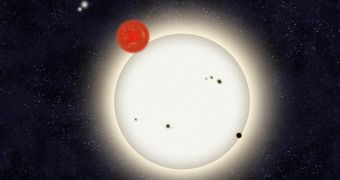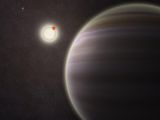Binary systems, with two stars orbiting each other, are quite common in the universe. And many of these systems have planets around them, it doesn't just happen in Star Wars. More complex systems are also known to exist. But the more stars you add to the mix, the more unstable the whole system is.
Still, a planet in a four-star system has now been discovered, and that's not even the most interesting thing, it was discovered by amateur astronomers over at the Planet Hunters website.
The planet's been named PH1, in honor of the site, and its existence has been confirmed by Yale astronomers. The planet is a gas giant, about the size of Uranus or Saturn, six times wider than the Earth.
It sits only 5,000 light years away and orbits two of the four stars in the system.
Those two stars orbit each other, a blue one that is hotter, brighter and about 1.5 times heavier than the Sun, the other red and small, about 0.41 as heavy as the Sun.
Two other stars orbit this system and orbit each other too, one similar to the Sun, the other a smaller red one. Yes, it is hard to keep track of it all. Astronomers are puzzled too and are now trying to figure out how such a complex system can be stable.
"This is Planet Hunters’ first confirmed planet, and we subsequently refer to the planet as PH1. The 6.18 ± 0.17 R⊕ planet orbits outside a 20-day period eclipsing binary. Beyond the orbit of PH1, a distant visual binary located at a projected distance of ∼1000 AU is bound to the planetary system," the paper presenting the discovery read.
The paper was signed by Yale astronomers who confirmed the find and studied the system further, but also by amateur astronomers from the Planet Hunter site that first found it.

 14 DAY TRIAL //
14 DAY TRIAL // 
